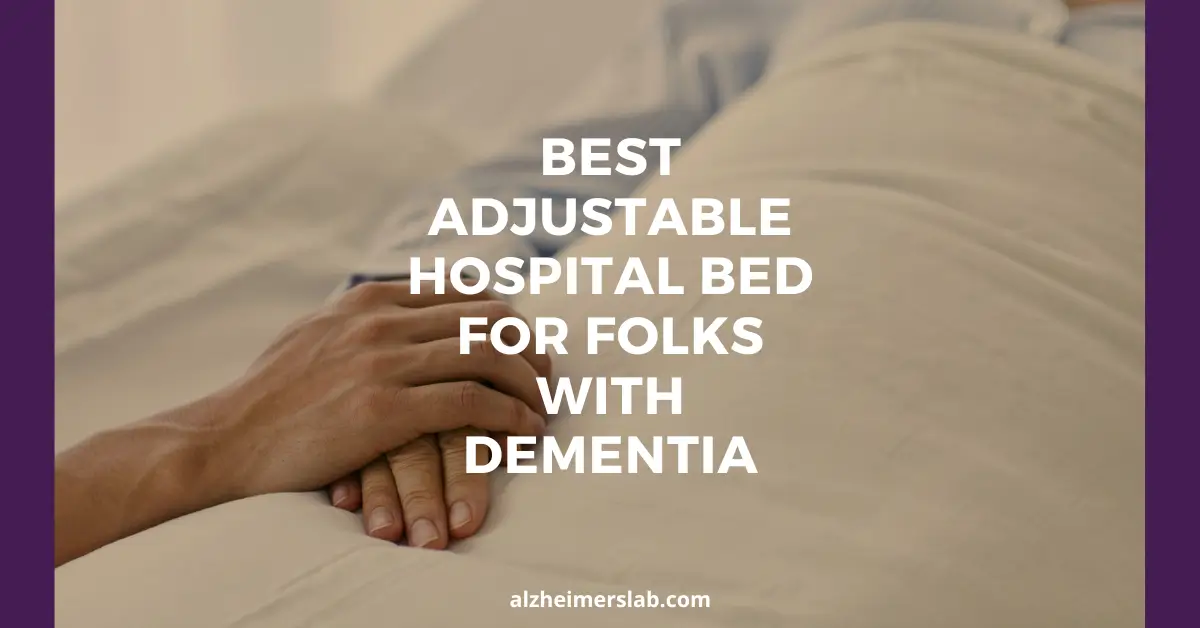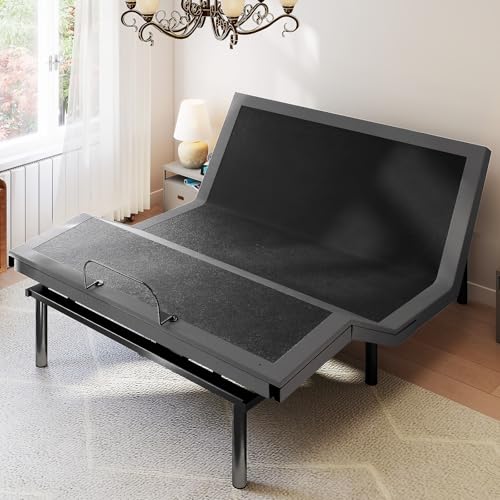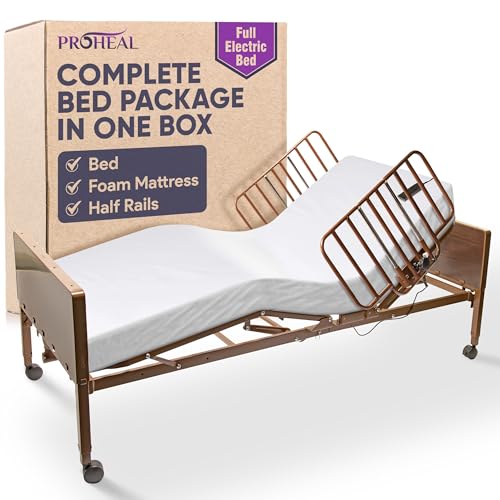Best Adjustable Hospital Bed with Remote Control For Those Living with Dementia
As an Amazon Associate, I earn from qualifying purchases
Finding the right hospital bed for a loved one with dementia isn’t just about comfort — it’s about safety, ease of use, and peace of mind. Whether you’re caring for a parent at home or setting up a more comfortable room for recovery, the search can be overwhelming. There are so many models with different features and price points, it’s hard to know what actually works.
I’ve done the research for you and picked out 5 of the best adjustable hospital beds with remote controls that offer the right mix of comfort, control, and caregiver-friendly features.
From premium options to budget-friendly picks, this list covers it all — so you can focus less on the guesswork and more on giving your loved one the support they need.
1. Careboda Full Electric Hospital Bed – Best Overall Choice
If you’re looking for a top-tier bed that truly feels like it was built for home caregivers and patients with dementia, the Careboda Full Electric Bed checks all the boxes. It’s not just sturdy and comfortable — it’s also whisper-quiet and packed with features that make life easier for both patient and caregiver.
Why I Recommend It:
Imagine being able to adjust the whole bed — head, foot, or height — with the touch of a button. No jerks, no noise. Whether your loved one is watching TV or resting, you can fine-tune the position for their comfort. The side rails are super helpful too — they give peace of mind that your loved one won’t roll off the bed at night.
Key Features:
- LINAK motors: Smooth, quiet, and reliable
- Full adjustability: Head, foot, and total bed height
- Easy-to-use remote control
- 5″ central-locking wheels for mobility
- Thick waterproof PU mattress included
- Weight support: Up to 529 lbs
Pros:
- Very sturdy and durable build
- Super quiet operation (great for dementia patients who get startled)
- Comes with a comfy mattress
- Easy assembly and caregiver-friendly design
Cons:
- Heavier unit, may take time to move into place
- On the higher end of the price range
2. Sweetcrispy Electric Bed – Best Budget-Friendly Pick
You don’t have to spend a fortune to get a reliable, adjustable bed for your loved one. The Sweetcrispy Electric Bed is proof. It’s affordable, easy to assemble, and surprisingly sturdy. Even folks recovering from strokes or dealing with scoliosis have said it made a big difference in their daily comfort.
Why I Recommend It:
It’s not hospital-grade, but it offers amazing value for the price. If you need a bed that adjusts smoothly and can help your loved one sit up or sleep comfortably — without breaking the bank — this is a solid pick.
Key Features:
- USB/USB-C charging ports built-in
- Simple remote-operated incline adjustments
- Fast, easy setup
- Works with standard memory foam mattresses
Pros:
- Great value for money
- Lightweight and easy to move
- Quiet and smooth operation
- Loved by users with mobility issues
Cons:
- Not suitable for very heavy individuals
- Doesn’t include mattress or rails
3. ESHINE Adjustable Bed with Hospital Mattress – Most Comfortable for Recovery
If your loved one spends a lot of time in bed due to illness or limited mobility, the ESHINE Adjustable Bed Set offers both support and comfort in one package. It includes a 6” waterproof hospital-grade mattress, plus full head and foot incline for ergonomic positioning.
Why I Recommend It:
The remote is easy for seniors to use, the mattress is soft yet firm, and it even comes with built-in lights for nighttime trips to the bathroom — small details that make a big difference in dementia care.
Key Features:
- Hospital waterproof mattress included
- Wireless 9-button remote
- Head incline: Up to 70°, foot incline: Up to 30°
- Under-bed lighting
- Built-in grab rails and headboard
Pros:
- Full bed set — no need to buy a mattress separately
- Super comfy and easy to use
- Lights and rails add safety and convenience
- Great for long-term use
Cons:
- Mattress is only 6” — some may prefer thicker
- Assembly may require two people
4. ProHeal Full Electric Bed (Model 1) – Best for Fall Prevention
For dementia patients, safety is a huge concern. This ProHeal Full Electric Bed includes half-rail safety guards and a pressure-redistributing mattress designed to prevent bed sores. If you’re worried about falls or skin breakdown, this model is a great option.
Why I Recommend It:
The height adjustment helps caregivers care for patients without strain, and the bed can go low enough to reduce injury risk in case someone tries to get out of bed unassisted.
Key Features:
- Hi-lo height: 15” to 23”
- Half rails for fall prevention
- Trendelenburg & Reverse Trendelenburg settings
- Quiet ETL-approved motors
- Pressure relief mattress included
Pros:
- Excellent safety features
- Built-in mattress for pressure relief
- Simple control pendant with large buttons
- Smooth, quiet motor operation
Cons:
- Basic design
- Slightly bulkier frame
5. ProHeal Full Electric Bed (Model 2) – Best for Bariatric Use
Need a little more strength and safety features? This upgraded ProHeal Bed supports up to 450 lbs and adds a recessed head/foot assembly to prevent pinching — a great option for larger individuals or those who move a lot in their sleep.
Why I Recommend It:
If your loved one has a larger build or you’re concerned about weight support and overall safety, this version is well worth considering. It has the same comfort and features as the other ProHeal bed but with added stability.
Key Features:
- 450 lb weight capacity
- 80″ x 36″ mattress with washable cover
- Safety-focused design to prevent injury
- Battery backup included (battery not included)
Pros:
- Great for heavier patients
- Built-in safety design to avoid injuries
- Very durable construction
- Height and angle adjustments are smooth
Cons:
- Slightly pricier than the standard version
- Battery not included
Buyer’s Guide: Choosing the Right Adjustable Hospital Bed with Remote Control for Dementia Care

If you’re caring for someone with dementia, an adjustable hospital bed can make life easier—for both of you. It helps your loved one stay comfortable and safe, and it saves your back from constant lifting and repositioning. But picking the right one can be confusing. There are so many models, prices, and features that it’s easy to get lost in the details.
Let’s keep it simple. Here’s how to choose a bed that actually makes sense for your home and your loved one’s needs.
1. Comfort and Adjustability
This is the heart of it all. Look for a bed that lets you raise and lower both the head and the legs smoothly with a remote control. This makes it easier to help your loved one eat, read, or just rest comfortably. Quiet motors are a big plus—no one wants a loud buzzing sound every time you adjust the bed at night.
Also, check if the bed offers “zero gravity” or “Trendelenburg” positions. Those are fancy terms, but all you need to know is that they can help improve circulation and reduce pressure points—something your loved one will thank you for.
2. Safety Features
When dementia is involved, safety becomes non-negotiable. Choose a bed with sturdy side rails that can be adjusted or removed as needed. Low beds are also great because they reduce the risk of injury from falls.
Some beds come with “auto-stop” features or slow descent settings—those are worth the extra money if your loved one tends to move or shift unexpectedly.
3. Ease of Use
You’ll be the one using that remote just as much as they will. Make sure the remote control is simple, clearly labeled, and has backlighting so you can see it at night.
It’s also worth checking how easy it is to change sheets, clean under the bed, and move it around if needed. Lockable wheels are a must if you plan to roll it for cleaning or repositioning.
4. Mattress Compatibility
Not all hospital beds include a mattress, and not all mattresses fit every bed. Look for ones that are compatible with pressure-relief or memory foam mattresses. A good mattress can make a world of difference in preventing bedsores and improving sleep quality.
If your loved one spends a lot of time in bed, investing in a high-quality mattress is just as important as choosing the right bed frame.
5. Weight Capacity and Build Quality
Hospital beds come in different weight capacities. Check the specs—if your loved one needs extra support, look for a “bariatric” model that can handle higher weights safely.
A sturdy steel frame tends to last longer than cheaper aluminum ones. Remember, this isn’t a short-term purchase; you want something that’s going to hold up for years.
6. Noise and Motion Smoothness
This might sound minor, but it’s not. Some cheaper electric beds make jerky movements or loud mechanical sounds. That can startle a person with dementia or disrupt their rest. Smooth, quiet operation can make nighttime adjustments much easier and less stressful for both of you.
7. Warranty and Support
This is one of those things you don’t think about until something breaks. Look for at least a one-year warranty on electrical parts and motor functions. Some companies even offer at-home servicing or replacement parts, which can save you a lot of trouble later.
How Much Should I Spend?
Most good-quality adjustable hospital beds with remote control range from $800 to $3,000. You can find budget models under $1,000, but those might have limited adjustability or shorter warranties.
If your loved one spends most of their day in bed, it’s worth investing in something mid-range or higher. Comfort, quiet motors, and durability are what you’re really paying for.
My Quick Advice
If you find yourself staring at fifteen tabs open and wondering if you should just put a recliner next to a regular bed—take a deep breath. Go for the bed that feels safe, quiet, and easy to use.
Think of it this way: this bed isn’t just furniture—it’s peace of mind (and fewer backaches for you). If it comes with a cup holder, well, that’s just a bonus.
You deserve a little comfort too.
Final Verdict: Which One Should You Choose?
If I had to pick just one, I’d go with the Careboda Full Electric Hospital Bed. It combines hospital-grade quality, easy remote control, excellent comfort, and top-notch safety — all in one sleek package. It’s perfect for dementia care at home, especially if you’re the primary caregiver and want a bed that truly supports both you and your loved one.
But if you’re working with a tighter budget, the Sweetcrispy Electric Bed offers incredible value without compromising on essentials.
Need help picking one for your specific situation? Drop a comment and I’ll be happy to guide you further!






